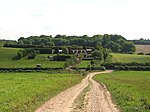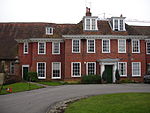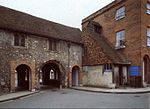Winchester Guildhall
City and town halls in HampshireGovernment buildings completed in 1875Grade II listed buildings in HampshireUse British English from April 2022

Winchester Guildhall is a municipal building in the High Street, Winchester, Hampshire. It is a Grade II listed building.
Excerpt from the Wikipedia article Winchester Guildhall (License: CC BY-SA 3.0, Authors, Images).Winchester Guildhall
Paternoster Row, Winchester The Close
Geographical coordinates (GPS) Address Nearby Places Show on map
Geographical coordinates (GPS)
| Latitude | Longitude |
|---|---|
| N 51.0614 ° | E -1.3124 ° |
Address
Mercure Winchester Wessex Hotel
Paternoster Row
SO23 9LQ Winchester, The Close
England, United Kingdom
Open on Google Maps










